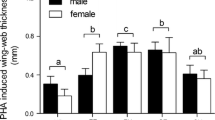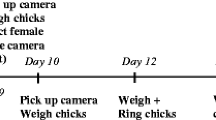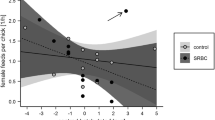Abstract
Cell-mediated immunity is an important vertebrate defense against pathogens, but components of this response may vary in quality. Such variation could arise through the effects of ecology on optimal immunocompetence. We used injections of phytohaemagglutinin (PHA) to measure the factors influencing T-cell proliferation in nestling house sparrows (Passer domesticus). Bivariate analyses revealed positive associations with nestling mass and size, but no effect of ectoparasites. The response to PHA was, however, strongly affected by brood identity. A mixed model with brood identity as a random factor and nestling mass, size, number of ectoparasites, parental feeding rate, clutch size, brood size at hatching, and date uncovered significant positive correlations between PHA response and both nestling mass and the brood size at hatching. Because many of these variables are related hierarchically, we used path analysis to explore the relationships in more detail. We found that a nestling immune response was affected by several indirect paths. Brood size at hatch had both positive and negative paths, and date in the season had several indirect negative effects through its effect on brood size and nestling mass. The approach used and the results obtained offer some new ideas for incorporating immune responses into life history theory.


Similar content being viewed by others
References
Alonso-Alvarez C, Tella JL (2001) Effects of experimental food restriction and body-mass changes on the avian T-cell-mediated immune response. Can J Zool 79:101–105
Birkhead TR, Fletcher F, Pellat EJ (1999) Nestling diet, secondary sexual traits and fitness in the zebra finch. Proc R Soc Lond B 266:385–390
Brinkhof MWG, Heeb P, Kölliker M, Richner H (1999) Immunocompetence of nestling great tits in relation to rearing environment and parentage. Proc R Soc Lond B 266:2315–2322
Christe P, Møller AP, de Lope F (1998) Immunocompetence and nestling survival in the house martin: the tasty chick hypothesis. Oikos 83:175–179
Christe P, Møller AP, Saino N, de Lope F (2000) Genetic and environmental components of phenotypic variation in immune response and body size of a colonial bird, Delichon urbica (the house martin). Heredity 85:75–83
Frank SA (2002) Immunology and evolution of infectious disease. Princeton University Press, Princeton, N.J.
Hatch MI (2003) Parental care in the life history of house sparrows. PhD Thesis, University of Kentucky
Hein WK, Westneat DF, Poston JP (2003) Sex of opponent influences response to a potential status signal in house sparrows. Anim Behav 65:1211–1221
Hoi-Leitner M, Romero-Pujante M, Hoi H, Pavlova A (2001) Food availability and immune capacity in serin (Serinus serinus) nestlings. Behav Ecol Sociobiol 49:333–339
Hõrak P, Tegelmann L, Ots I, Møller AP (1999) Immune function and survival of great tit nestlings in relation to growth conditions. Oecologia 121:316–322
Imonen P, Hasselquist D, Langefors A, Weihn J (2003) Stress, immunocompetence and leukocyte profiles of pied flycatchers in relation to brood size manipulation. Oecologia 136:148–154
Kinnard TB (2002) Analysis of variation in phenotypic traits through the life history of house sparrows. MSc Thesis, University of Kentucky
Lessells CM, Boag PT (1987) Unrepeatable repeatabilities: a common mistake. Auk 104:116–122
Lochmiller RL, Vestey MR, Boren JC (1993) Relationship between protein nutritional status and immunocompetence in northern bobwhite chicks. Auk 110:503–510
Merino S, Martinez J, Møller AP, Sanabria L, de Lope F, Perez J, Rodriguez-Caabeiro F (1999) Phytohaemagglutinin injection assay and physiological stress in nestling house martins. Anim Behav 58:219–222
Navarro C, Marzal A, de Lope F, Møller AP (2003) Dynamics of an immune response in house sparrows Passer domesticus in relation to time of day, body condition and blood parasite infection. Oikos 101:291–298
Parmentier HK, Schrama JW, Meijer F, Nieuwland MGB (1993) Cutaneous hypersensitivity responses in chickens divergently selected for antibody responses to sheep red blood cells. Poult Sci 72:1679–1692
Parmentier HK, Siemonsma R, Nieuwland MGB (1994) Immune responses to bovine serum albumin in chicken lines divergently selected for sheep erythrocytes. Poult Sci 73:825–835
Poiani A, Goldsmith AR, Evans MR (2000) Ectoparasites of house sparrows (Passer domesticus): an experimental test of the immunocompetence handicap hypothesis and a new model. Behav Ecol Sociobiol 47:230–242
Råberg L, Grahn M, Hasselquist D, Svensson E (1998) On the adaptive significance of stress-induced immunosuppression. Proc R Soc Lond B 265:1637–1641
Royle NJ, Surai PF, Hartley IR (2003) The effect of variation in dietary intake on maternal deposition of antioxidants in zebra finch eggs. Funct Ecol 17:472–481
Saino N, Calza S, Møller AP (1997) Immunocompetence of nestling barn swallows in relation to brood size and parental effort. J Anim Ecol 66:827–836
Saino N, Calza S, Møller AP (1998) Effects of a dipteran ectoparasite on immune response and growth trade-offs in barn swallow, Hirundo rustica, nestlings. Oikos 81:217–228
Sheldon BC, Verhulst S (1996) Ecological immunology: costly parasite defenses and trade-offs in evolutionary ecology. Trends Ecol Evol 11:317–321
Smits JE, Bortolotti GR, Tella JL (1999) Simplifying the phytohaemagglutinin skin-testing technique in studies of avian immunocomptence. Funct Ecol 13:567–572
Sokal RR, Rohlf FJ (1981) Biometry, 2nd edn. Freeman, San Francisco
Sorci G, Soler JJ, Møller AP (1997) Reduced immunocompetence of nestlings in replacement clutches of the European magpie (Pica pica). Proc R Soc Lond B 264:1593–1598
Tella JL, Bortolotti GR, Dawson RD, Forero MG (2000a) The T-cell-mediated immune response and return rate of fledgling American kestrels are positively correlated with parental clutch size. Proc R Soc Lond B 267:891–895
Tella JL, Bortolotti GR, Forero MG, Dawson RD (2000b) Environmental and genetic variation in T-cell-mediated immune response of fledgling American kestrels. Oecologia 123:453–459
Tella JL, Forrero MG, Bertellotti M, Donázar JA, Blanco G, Ceballos O (2001) Offspring body condition and immunocompetence are negatively affected by high breeding densities in a colonial seabird: a multiscale approach. Proc R Soc Lond B 268:1455–1461
Tella JL, Scheuerlein A, Ricklefs RE (2002) Is cell-mediated immunity related to the evolution of life-history strategies in birds? Proc R Soc Lond B 269:1059–1066
Tschirren B, Fitze PS, Richner H (2003) Sexual dimorphism in susceptibility to parasites and cell-mediated immunity in great tit nestlings. J Anim Ecol 72:839–845
Westneat DF, Birkhead TR (1998) Alternative hypotheses linking the immune system with mate choice for good genes. Proc R Soc Lond B 265:1065–1073
Westneat DF, Stewart IRK, Woeste EH, Gipson J, Abdulkadir L, Poston JP (2002) Patterns of sex ratio variation in house sparrows. Condor 106:598–609
Zuk M, Johnsen TS (1998) Seasonal changes in the relationship between ornamentation and immune response in red jungle fowl. Proc R Soc Lond B 265:1631–1635
Acknowledgements
Ian Stewart, Margret I. Hatch, Hannah Shaefer and Katie Chipko assisted with data collection and measurements. Funds for this project were provided by NSF grant IBN9816989 to D.F.W., supplemental funding from the NSF Research Experiences for Undergraduates program to J.W. and R.M.E., and the University of Kentucky. All procedures were approved by the University of Kentucky’s Institutional Animal Care and Use Committee. We thank Victor Apanius, José Tella, and two anonymous reviewers for suggestions that improved the manuscript.
Author information
Authors and Affiliations
Corresponding author
Rights and permissions
About this article
Cite this article
Westneat, D.F., Weiskittle, J., Edenfield, R. et al. Correlates of cell-mediated immunity in nestling house sparrows. Oecologia 141, 17–23 (2004). https://doi.org/10.1007/s00442-004-1653-9
Received:
Accepted:
Published:
Issue Date:
DOI: https://doi.org/10.1007/s00442-004-1653-9




